Apple Puree for Babies: Recipes and Safety Guidelines
When you're introducing apple puree to your baby, it's essential to consider both the nutritional benefits and safety guidelines that come with it. You'll want to select the right apple varieties, prepare them correctly, and watch for any signs of allergies. Plus, there are plenty of tasty variations you can experiment with to keep mealtime interesting for your little one. As you think about the best ways to serve apple puree, you might be curious about some common mistakes to avoid—let's explore those next.
Benefits of Apple Puree

Apple puree offers numerous benefits that can enhance your baby's nutrition and taste experience. First off, it's packed with essential vitamins and minerals. Apples are rich in vitamin C, which helps support your baby's immune system, and they also contain dietary fiber, promoting healthy digestion.
When you introduce apple puree, you're giving your little one a tasty way to get these nutrients.
Another great perk is its natural sweetness. Babies are often drawn to sweet flavors, and apple puree can serve as a delightful introduction to solid foods. You'll find that this smooth texture makes it easy for your baby to consume, reducing the risk of choking.
Plus, it's incredibly versatile! You can mix apple puree with other fruits or cereals to create a variety of flavors, keeping mealtime exciting.
Also, homemade apple puree is a budget-friendly option. It's easy to make in batches and store for later use, ensuring you always have a nutritious snack on hand.
Choosing the Right Apples
When selecting the right apples for puree, consider varieties that are naturally sweet and have a smooth texture. Apples like Fuji, Gala, and Honeycrisp are excellent choices because they offer a delightful sweetness without needing added sugar. These apples also mash easily, making them perfect for pureeing.
Avoid tart varieties, such as Granny Smith, as their sour flavor mightn't appeal to your little one. When you pick apples, look for ones that are firm and free from bruises or blemishes. This ensures you're getting fresh fruit that will yield the best puree.
If possible, choose organic apples to reduce exposure to pesticides, especially since babies can be more sensitive to chemicals.
Another tip is to consider the season. Apples are typically at their best in the fall, so buying them fresh during this time can enhance the flavor and quality of your puree.
Lastly, don't hesitate to ask for recommendations from local farmers or at your grocery store. They can guide you to the best options available in your area.
Simple Apple Puree Recipe
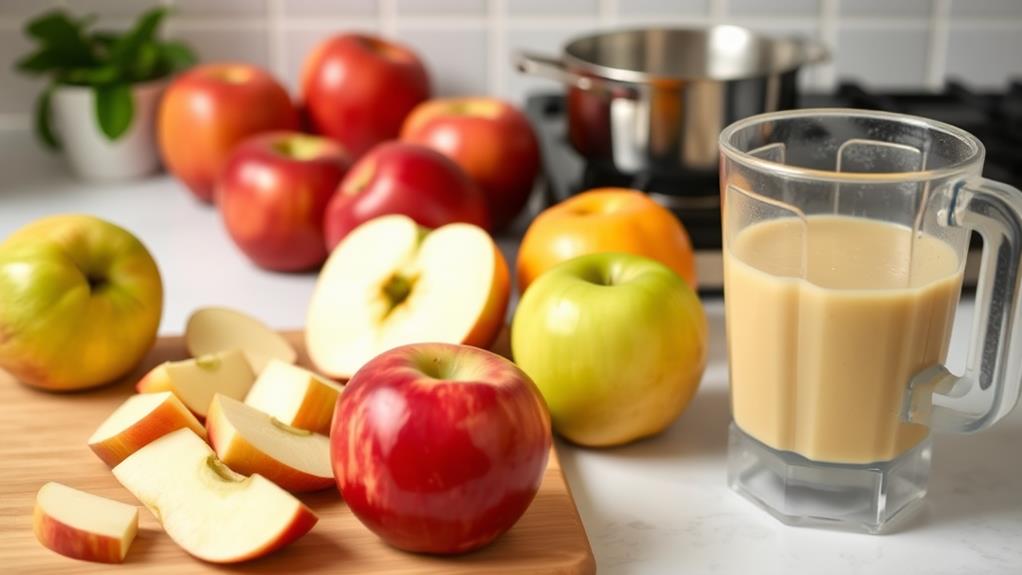
Now that you've selected the perfect apples, it's time to turn them into a simple and tasty puree for your baby.
Start by washing your apples thoroughly to remove any dirt or pesticides. Peel them, then core and chop them into small pieces to make cooking easier.
Next, place the chopped apples in a pot and add about a half cup of water. This will help steam the apples and keep them from sticking to the bottom.
Cook the apples over medium heat, stirring occasionally, until they become soft and tender, which usually takes about 10 to 15 minutes.
Once they're cooked, remove them from heat and let them cool slightly. You can use a blender or food processor to puree the apples until they reach your desired consistency.
If you want a smoother texture, you can add a little more water as you blend.
Flavor Variations to Try
Exploring flavor variations can make your baby's apple puree even more exciting and nutritious. By adding different ingredients, you can introduce your little one to a world of flavors.
Try mixing in a pinch of cinnamon for a warm, comforting taste that many babies love. You could also add a few mashed bananas for natural sweetness and creaminess.
If you're feeling adventurous, consider combining apples with pears. This duo creates a delightful blend that's sure to please your baby's palate.
For a touch of tartness, mix in some cooked blueberries or strawberries. These fruits not only taste great, but they also pack a nutritional punch.
For a savory twist, you can experiment with a small amount of cooked sweet potato or butternut squash, which will add both flavor and nutrients.
Remember to introduce new flavors one at a time, watching for any reactions.
With these variations, you can keep mealtime fun and help your baby develop a love for diverse tastes. So, grab those apples and get creative—your baby's taste buds will thank you!
Preparing Apple Puree Safely
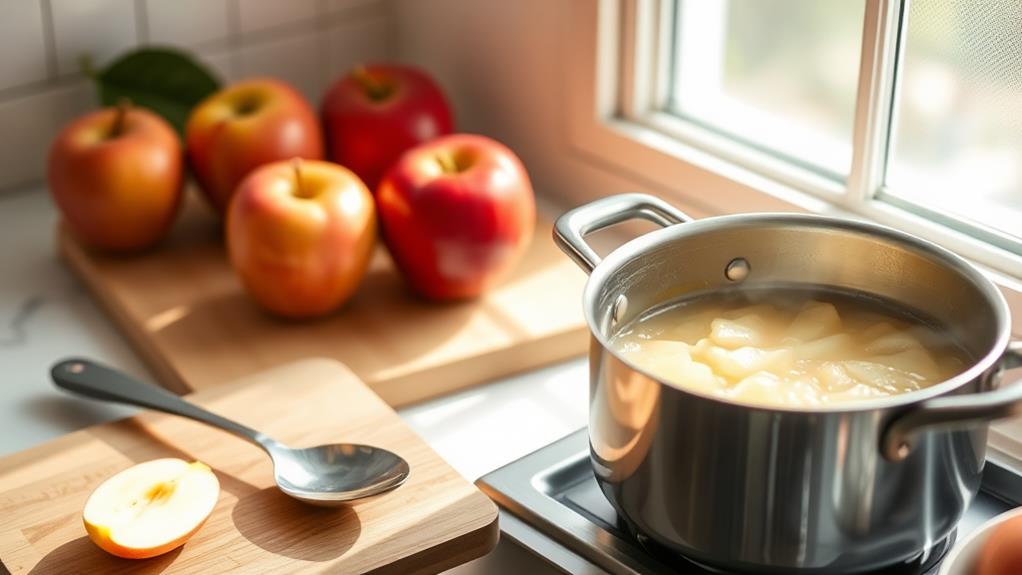
Making apple puree safely is essential for your baby's health. To start, always choose fresh, organic apples when possible. Washing the apples thoroughly under running water removes any pesticides or dirt. After washing, peel the apples to eliminate any potential contaminants on the skin.
Next, core and chop the apples into small pieces to ensure even cooking. You can steam or boil the chopped apples until they're tender, usually about 10 to 15 minutes. This method helps retain nutrients while making the apples easier to puree.
Once cooked, drain any excess water and blend the apples in a food processor or blender until you achieve a smooth consistency. If the puree is too thick, you can add a little water or breast milk to reach your desired texture.
Always taste the puree yourself to ensure it's not too hot before feeding it to your baby.
Remember to clean all utensils and surfaces you used during preparation to avoid cross-contamination. Following these simple steps will help you create delicious and safe apple puree for your little one. Enjoy this fun and rewarding process!
Storage Tips for Puree
Once you've prepared your apple puree, proper storage is key to keeping it fresh and safe for your baby. Start by letting the puree cool completely before storing it. If you plan to use it within a few days, you can keep it in an airtight container in the refrigerator. It's best to use it within three days for optimal freshness.
For longer storage, consider freezing the puree. Use ice cube trays to portion out the puree, then cover them with plastic wrap or a lid. Once frozen, transfer the cubes to a labeled freezer bag. This way, you can easily thaw just the amount you need later. Apple puree can be stored in the freezer for up to three months.
When you're ready to use frozen puree, simply thaw it in the refrigerator overnight or warm it gently in a saucepan. Always check the temperature before serving to ensure it's safe for your little one.
Serving Sizes for Babies
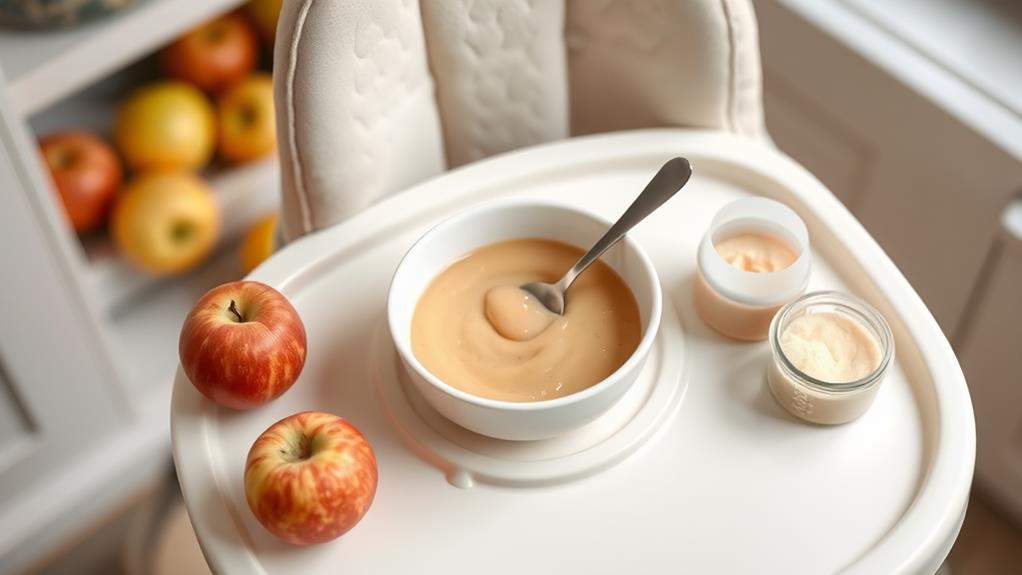
When introducing apple puree to your baby, it's important to consider appropriate serving sizes to ensure they're getting the right amount for their age and developmental stage. For babies starting solids, around six months old, you can begin with one to two teaspoons of apple puree. This small amount helps them adjust to new textures and flavors without overwhelming them.
As your baby grows and becomes more accustomed to solid foods, you can gradually increase the serving size. By eight to nine months, offering about two to four tablespoons is typically suitable. At this stage, your little one might enjoy mixing apple puree with other fruits or cereals, introducing variety to their diet.
Keep in mind that every baby is different, and their appetite can vary day by day. Watch for cues that signal they're full, like turning their head away or closing their mouth.
It's essential to be flexible with portions and ensure your baby enjoys their meals. Remember, the goal is to create a positive feeding experience while providing the nutrients they need.
Signs of Allergies to Watch
As you introduce apple puree to your baby, it's crucial to be aware of potential allergy signs. While apples are generally safe, some babies can still react. Watch for symptoms like rash, hives, or swelling around the face and mouth. These can appear shortly after your baby eats the puree.
Also, keep an eye out for gastrointestinal issues. If your little one has diarrhea, vomiting, or seems unusually fussy after eating, it could be a sign of an allergic reaction.
Other signs to note include difficulty breathing or wheezing, which may indicate a more severe allergy. If you notice any of these symptoms, don't hesitate to contact your pediatrician for guidance. They can provide you with helpful information and may suggest allergy testing if necessary.
Always remember to introduce new foods one at a time, waiting a few days before adding another. This way, you can better identify any food-related issues.
Keeping a food diary can also help track what your baby eats and any reactions they experience. By staying vigilant, you can help ensure your baby's transition to solid foods is both enjoyable and safe.
Incorporating Puree Into Meals
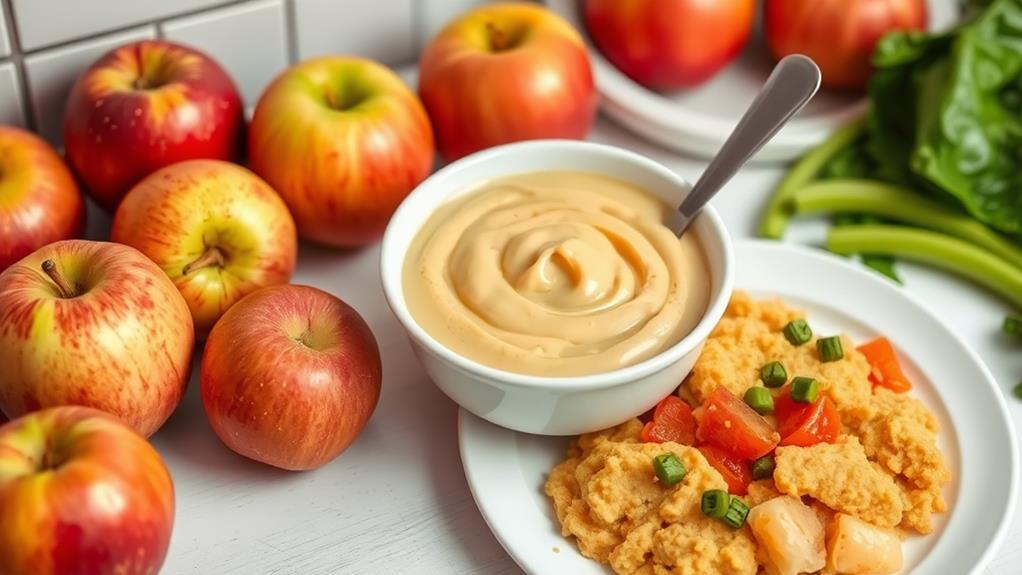
After ensuring your baby has no allergic reactions, you can start incorporating apple puree into their meals. This delightful fruit puree can be a nutritious addition that not only enhances flavor but also adds essential vitamins to your little one's diet.
You can mix it with other purees like sweet potato or carrots to create tasty combinations. Consider serving apple puree as a standalone snack or dessert. You can also spread it on toast or mix it into oatmeal for a breakfast treat.
If you're feeling adventurous, try blending it with yogurt for a creamy snack that'll keep your baby satisfied.
Don't forget that apple puree can be a great way to introduce your baby to new textures and flavors. Gradually increasing the amount you serve will help your baby adjust and develop their palate.
As you incorporate apple puree into meals, keep an eye on your baby's reactions. This will help you gauge their preferences and ensure they enjoy this new addition to their diet.
With a little creativity, you'll discover plenty of delicious ways to make apple puree a staple in your baby's meals!
Essential Safety Guidelines
To ensure your baby's safety while enjoying apple puree, it's crucial to follow some essential guidelines.
First, always wash apples thoroughly before cooking or pureeing them. This helps remove any pesticides or dirt. Next, peel the apples, as the skin can be tough for little ones to digest. When cooking, steam or boil the apples until they're soft, making them easier to puree.
Once you've made the puree, check the temperature before feeding it to your baby. It should be warm, not hot, to prevent burns.
Store any leftovers properly; use an airtight container and keep it in the fridge for up to three days or freeze it for later use.
Introduce apple puree to your baby's diet gradually, starting with small amounts to watch for any allergic reactions. If your baby shows signs of an allergy, like rash or stomach upset, stop feeding them the puree and consult your pediatrician.
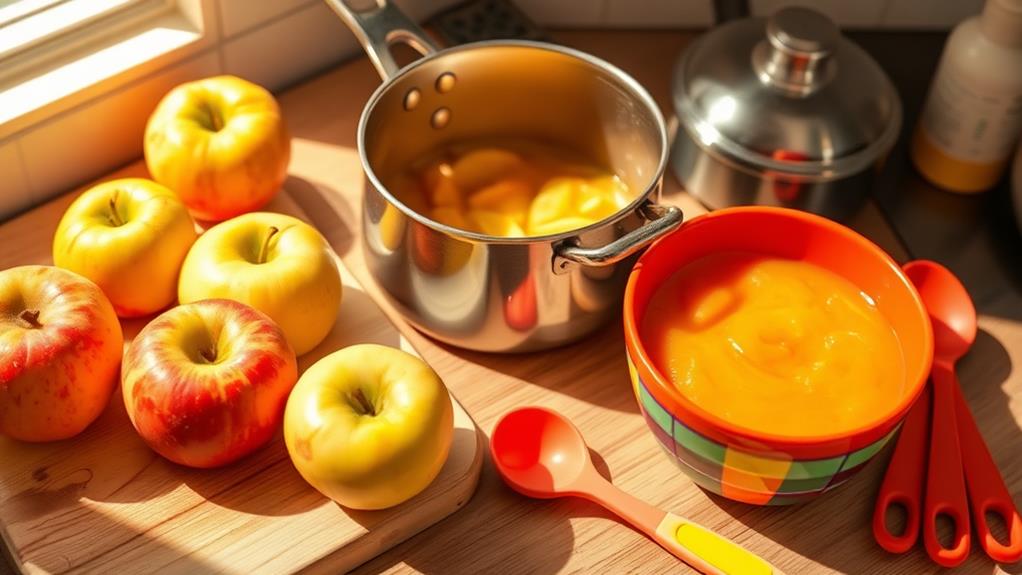










Post Comment